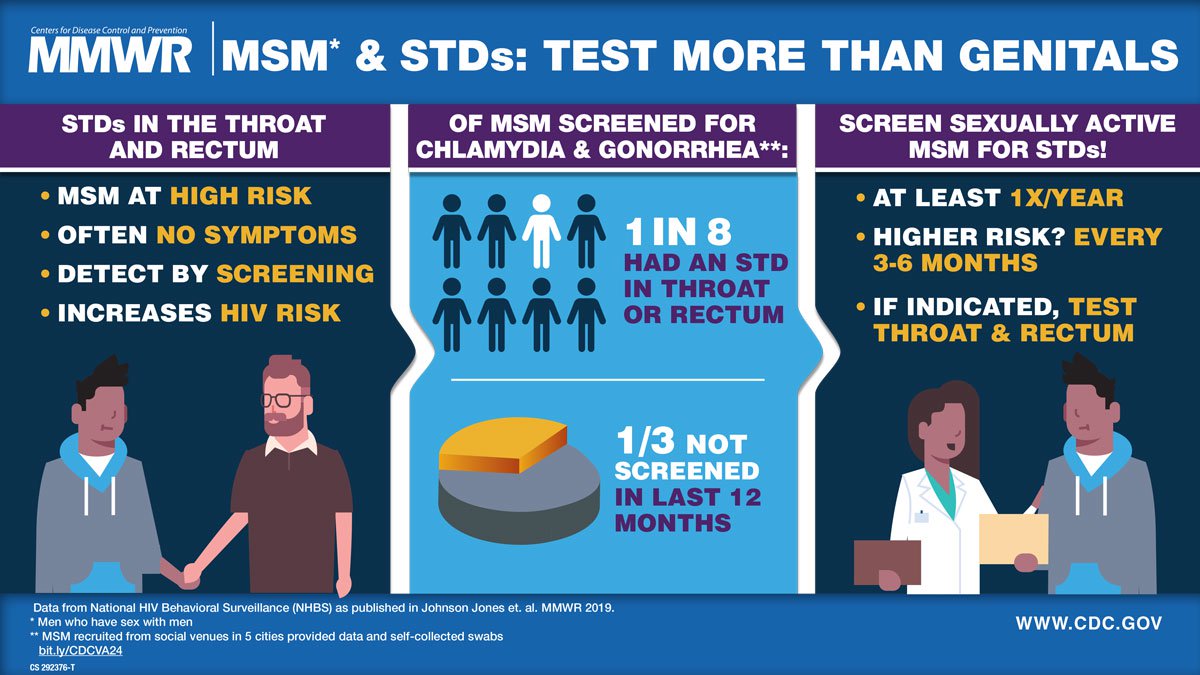Extragenital STDs prevalent among MSM recruited in nonclinical settings
CDC surveillance data from five U.S. cities showed that around 13% of men who have sex with men, or MSM, who were recruited from nonclinical community settings like bars, clubs and fitness centers tested positive for at least one extragenital chlamydial or gonococcal infection.
That is a lower rate of rectal or pharyngeal STDs than is typically seen in MSM. However, most other prevalence estimates are derived from studies conducted at HIV and STD clinics, not in the community, CDC researcher Michelle L. Johnson Jones, MPH, and colleagues from the National HIV Behavioral Surveillance Sexually Transmitted Infection Study Group, explained.
Writing in MMWR, they said the newly published results illustrate the high risk for chlamydia and gonorrhea that MSM face.
“This finding suggests that the general population of sexually active MSM might be at elevated risk for STDs and that bacterial STD prevalence estimates from STD clinic-based samples of MSM might not be substantially biased,” they wrote.

Among the more than 2,000 study participants recruited from venues in Houston, Miami, New York, San Francisco and Washington, around 33% said they had not been tested for STDs in the previous 12 months, despite CDC guidance saying sexually active MSM should be screened at least annually.
The United States is in the midst of an STD resurgence, with a record number of infections reported in each of the past 3 years.
“The asymptomatic nature of extragenital STDs and high prevalences found in [MSM] further support the need for regular screening of all sexually active MSM at all anatomic sites of exposure,” the researchers wrote. “Improved access to culturally competent care and clinician adherence to screening guidelines for MSM are critical components in reducing the STD disparities that affect this population.”
The researchers restricted the study population to adults who identified as male and reported having sex with a man in the previous 12 months. The participants were interviewed, offered an anonymous HIV test and asked to self-collect rectal and pharyngeal swabs to test for chlamydia and gonorrhea. They were offered “monetary tokens of appreciation” for participating.
According to the researchers, most provided specimens for testing. Among the 2,075 participants included in the final analysis, test results showed that:
- 13.3% (95% CI = 11.8%–14.8%) were infected with at least one of the two STDs at one or two anatomic sites;
- the prevalence of rectal chlamydia (7.3%) was higher than that of rectal gonorrhea (4.5%; P < .001);
- the prevalence of pharyngeal gonorrhea (4.6%) was higher than that of pharyngeal chlamydia (1.4%; P < .001);
- the prevalence of rectal gonorrhea was higher among MSM who reported being HIV positive than among those who were HIV negative (8.2% vs. 3.3%; P < .001);
- participants aged 18 to 29 years were more likely than older participants to test positive for each infection except pharyngeal chlamydia; and
- the only racial or ethnic difference in prevalence was that black and Hispanic participants were likelier to have pharyngeal gonorrhea.
The researchers noted at least four limitations to the study, including that it was conducted in just five cities, though they noted that the cities are “geographically and sociodemographically diverse.” Among them, San Francisco had the lowest prevalence for each infection and anatomic site, they reported – by Gerard Gallagher
Reference:
Johnson Jones ML, et al. MMWR Morb Mortal Wkly Rep. 2019;doi:10.15585/mmwr.mm6814a1.
Disclosures: The researchers report no relevant financial disclosures.
